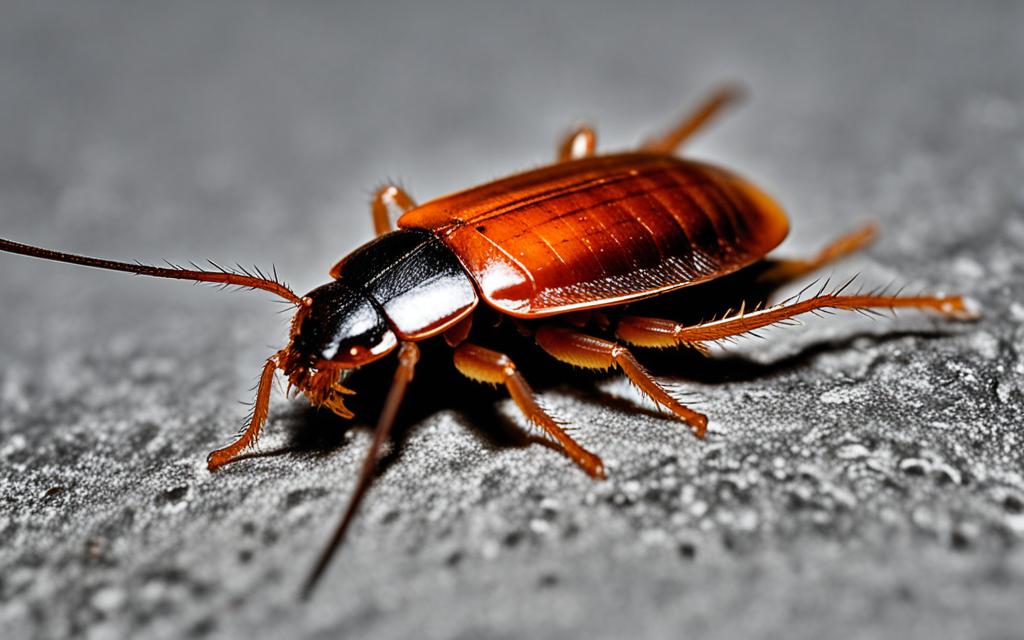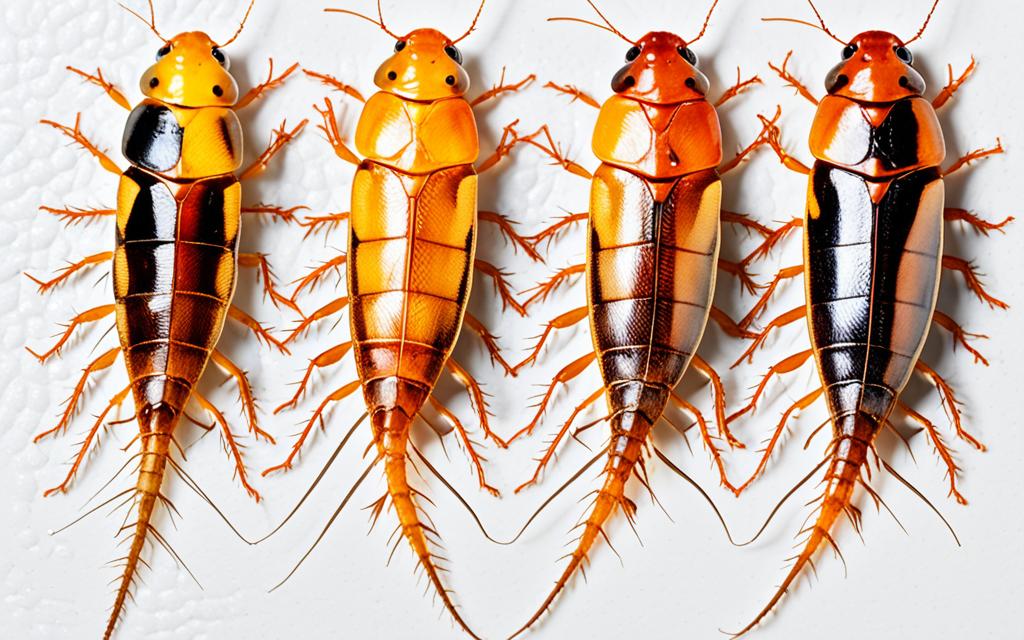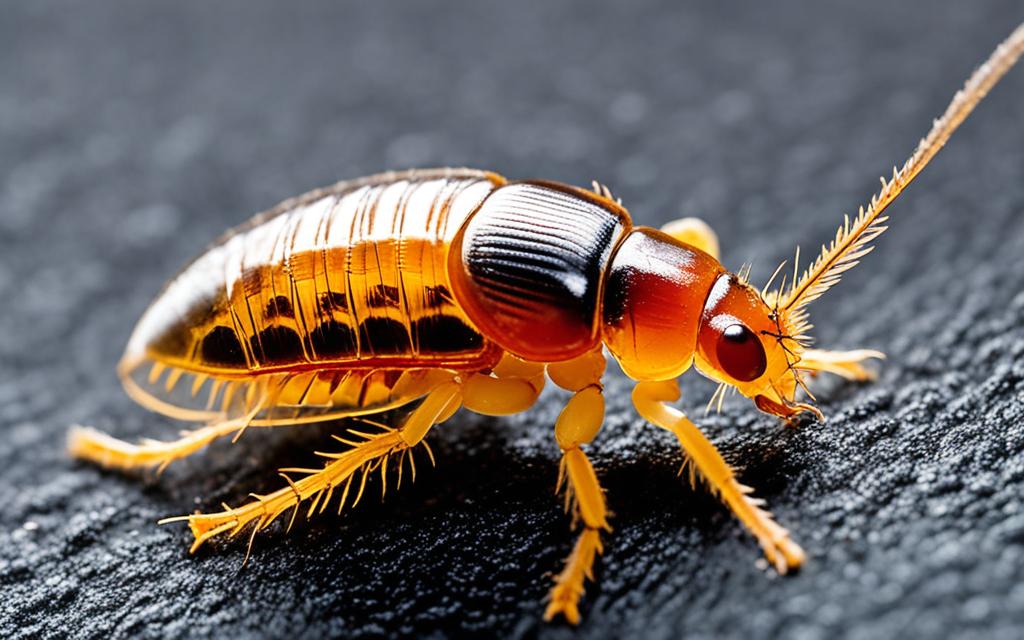Have you ever wondered what do baby roaches look like? These tiny pests can be a cause of concern for homeowners, as they multiply quickly and can infest your living spaces. In this section, we will explore the appearance and characteristics of baby roaches, helping you identify these pests in your home.
- Baby roaches are smaller in size compared to adult roaches, typically ranging from 1/8 inch to 1/4 inch in length.
- The color of baby roaches can vary, but most are light brown or a translucent whitish color.
- They have oval-shaped bodies with six legs, long antennae, and small wings that are not fully developed.
- Baby roaches, also known as nymphs, have a lighter color, softer exoskeleton, and smaller size compared to adults.
- Some baby roaches may have distinct markings or patterns on their bodies, but not all do.
Now that you have a better understanding of what baby roaches look like, let’s delve deeper into their size, color, body shape, and other notable characteristics. By being able to identify these pests, you’ll be better equipped to take the appropriate steps to prevent and control an infestation in your home.
Baby Roach Size and Color
When it comes to identifying baby roaches, their size and color can provide valuable clues. Baby roaches are typically smaller in size compared to adult roaches, measuring between 1/8 inch to 1/4 inch in length. This miniature stature makes them challenging to spot, especially in dimly lit areas of your home.
The color of baby roaches can vary depending on the species. However, most baby roaches are commonly light brown or have a translucent whitish color. These lighter hues distinguish them from their adult counterparts, allowing for easier differentiation.
It’s important to note that the size and color of baby roaches can slightly differ based on the species, making it crucial to have a comprehensive understanding of their characteristics for accurate identification.
Did You Know? Baby roaches are also known as nymphs, which refers to the immature stage of the roach life cycle. Nymphs undergo multiple molts, shedding their exoskeletons as they grow into adults.
| Baby Roach Size | Baby Roach Color |
|---|---|
| Usually 1/8 inch to 1/4 inch in length | Light brown or translucent whitish color |
Baby Roach Body Shape
When it comes to baby roaches, their body shape closely resembles that of their adult counterparts. They have oval-shaped bodies, which are a distinguishing feature of roaches in general. With six legs, long antennae, and small wings, baby roaches exhibit the typical characteristics of these pests.
However, it’s important to note that the wings of baby roaches are not fully developed, preventing them from flying at this stage of their life cycle. As they grow and mature into adults, their wings will undergo further development, allowing them to take flight.
Having a clear understanding of the body shape and features of baby roaches can assist you in identifying these pests in your home.
Baby Roach Nymphs vs. Adults
When it comes to identifying baby roaches, it’s important to understand the differences between nymphs and adults. Baby roaches, also known as nymphs, exhibit distinct characteristics that set them apart from their adult counterparts.
One of the key differences is their size. Baby roaches are significantly smaller than adult roaches, measuring between 1/8 inch to 1/4 inch in length. Their smaller size makes it easier for them to hide in tight spaces and go unnoticed.
In addition to their size, baby roaches have a lighter color compared to adults. While adult roaches typically have a darker brown or black coloration, baby roaches are usually a lighter shade of brown or even translucent whitish color.
The exoskeleton of baby roaches is also different from that of adults. Nymphs have a softer exoskeleton, which gradually hardens as they mature into adults. This difference in exoskeleton texture can be used as a visual cue to distinguish baby roaches from their adult counterparts.
Furthermore, baby roaches have limited reproductive capabilities until they reach adulthood. Unlike adult roaches, which are capable of reproducing, baby roaches are not sexually mature and cannot reproduce until they have fully developed into adults.
To help you visualize the differences between baby roach nymphs and adults, take a look at the image below:
| Characteristics | Baby Roach Nymphs | Adult Roaches |
|---|---|---|
| Size | 1/8 inch to 1/4 inch | Varies depending on the species |
| Color | Light brown or translucent whitish | Dark brown or black |
| Exoskeleton | Softer | Harder |
| Reproductive Ability | Limited until adulthood | Capable of reproduction |
By familiarizing yourself with the characteristics of baby roach nymphs, you can improve your ability to identify and address potential infestations in your home.
Baby Roach Markings and Patterns
While baby roaches may vary in appearance depending on the species, some individuals exhibit specific markings or patterns on their bodies. These distinct features can range from simple lines or dots to more complex and intricate designs.
However, it’s important to note that not all baby roaches have highly visible and easily discernible markings. Some species may have more subtle variations in color or texture, making it challenging to identify specific patterns.
If you encounter baby roaches with unique markings, it can be helpful for identification purposes and understanding the species’ characteristics. Additionally, observing patterns on baby roaches may assist in differentiating them from adult roaches.
Here is an example of a baby roach with distinct markings:
| Species | Description |
|---|---|
| American Cockroach | This species of baby roach often has dark parallel lines running along its thorax, which gradually fade as they grow into adults. |
| German Cockroach | Some baby German cockroaches may display small, spotted patterns on their abdomen. |
| Oriental Cockroach | While baby oriental cockroaches typically lack distinct markings, their dark brown or black coloration makes them easily recognizable. |
It’s crucial to remember that accurate identification of baby roaches based solely on markings may pose challenges due to variations within species and gradual changes as they develop into adults. Therefore, it’s recommended to rely on multiple characteristics and seek professional pest control assistance when necessary.
Baby Roach Pictures and Images
Visual aids are incredibly helpful when it comes to understanding the appearance of baby roaches. In this section, we provide you with pictures and images of baby roaches to assist you in identifying these pests accurately.
Take a look at the following images to get a better idea of what baby roaches look like:
| Baby Roach Species | Image |
|---|---|
| American Cockroach | https://www.youtube.com/watch?v=QxOidL3f97c |
| German Cockroach | |
| Oriental Cockroach |
These pictures showcase the distinct characteristics and features of baby roaches. By familiarizing yourself with their appearance, you’ll be better equipped to identify and address a potential infestation.
Where to Find Baby Roaches
Baby roaches, also known as nymphs, can be found in various areas of your home where they have easy access to food, moisture, and shelter. These tiny pests prefer dark and secluded spaces to hide and thrive.
Here are some common places to look for baby roaches:
- Kitchen cabinets and drawers: Baby roaches are often found hiding in the corners or crevices of kitchen cabinets and drawers, particularly near sources of food and water. Keep an eye out for them when you’re organizing your kitchen.
- Behind appliances: Roaches, including baby ones, can take refuge behind appliances like refrigerators, stoves, and dishwashers. Check these areas regularly to spot any signs of infestation.
- Cracks and crevices: Nymphs can squeeze through tiny cracks and crevices in walls, baseboards, and floors. Inspect these areas carefully, as they can provide hiding spots for baby roaches.
- Bathroom areas: Baby roaches are attracted to moisture, making bathrooms one of their preferred hiding spots. Pay close attention to areas around sinks, toilets, and showers.
- Basements and crawl spaces: Dark and damp environments like basements and crawl spaces provide suitable conditions for baby roaches to survive and reproduce. Thoroughly inspect these areas if you suspect a roach problem.

If you come across baby roaches in any of these locations, it’s important to act quickly to prevent a full-blown infestation. Adopting proper hygiene practices, sealing entry points, and seeking professional help, if necessary, can help control and eliminate these unwelcome pests.
Signs of Baby Roach Infestation
The presence of baby roaches is a clear indication of an infestation. By knowing the signs to look for, you can quickly identify if your home is being invaded by these unwanted pests.
Shed Skins
One of the telltale signs of a baby roach infestation is finding their shed skins. As baby roaches grow, they molt and shed their exoskeletons. These discarded skins can be found near their hiding spots, such as behind appliances or in dark corners. If you notice small, translucent shells resembling the shape of a roach, it’s a strong indicator of their presence.
Feces
Baby roaches leave behind feces that are smaller in size compared to adult roach droppings. These droppings are often black or brown and appear as small specks or smears on surfaces. They are commonly found along baseboards, countertops, or in areas where the roaches frequent.
Smear Marks
When baby roaches crawl along surfaces, they can leave smear marks behind. These marks are often a result of the oily substances that baby roaches produce as they move. Look for irregular streaks or smudges on walls, floors, or furniture, as they can be a sign of ongoing roach activity.
If you observe any of these signs in your home, it’s crucial to take immediate action to control the infestation. Removing baby roaches early can prevent further breeding and growth, ensuring a pest-free environment for you and your family.
Prevention and Control of Baby Roaches
When it comes to baby roaches, prevention is key. By taking proactive measures to eliminate their entry into your home and implementing effective control methods, you can protect your living space from a potential infestation.
Preventive Measures
Here are some tips to keep baby roaches at bay:
- Keep your home clean and tidy, focusing on regular vacuuming and sweeping to reduce food debris and hiding places.
- Store food in airtight containers and promptly clean up any spills or crumbs.
- Seal cracks and crevices in walls, floors, and foundations to prevent roaches from gaining entry.
- Repair any leaking pipes or faucets to eliminate moisture, as roaches are attracted to damp environments.
- Keep garbage cans tightly sealed and dispose of trash regularly.
- Trim vegetation and remove clutter from around the exterior of your home to deter roaches from nesting.
Controlling an Infestation
If you suspect a baby roach infestation in your home, here are some effective control methods:
- Identify and eliminate the source of the infestation, such as food and water sources, feces, or nests.
- Use roach baits or traps to capture and kill baby roaches.
- Apply insecticides specifically formulated for roach control. Be sure to follow the instructions carefully and take necessary precautions.
- Consult with a professional pest control service for advanced treatment options and to ensure thorough eradication of baby roaches.
Remember, tackling a baby roach infestation requires persistence and consistency in implementing preventive measures and control methods. By addressing the issue promptly and effectively, you can safeguard your home and family from these unwanted pests.
In the image above, you can see an example of a baby roach. Notice its smaller size and lighter color compared to adult roaches. Understanding the appearance and characteristics of baby roaches is crucial for successful identification and control.
Professional Extermination Services
If you’ve identified baby roaches in your home and your efforts to control them have been unsuccessful, it may be necessary to seek professional extermination services. While DIY methods can be effective for minor infestations, severe infestations or recurring problems may require the expertise of pest control professionals.
Professional exterminators are experienced in dealing with all types of roach infestations, including baby roaches. They have the knowledge, skills, and specialized tools to effectively identify and eliminate these pests from your home.
Hiring professionals for baby roach extermination offers several benefits:
- Expertise: Pest control professionals are trained to identify different species of roaches, including baby roaches. They can accurately assess the extent of the infestation and develop a targeted treatment plan.
- Safe and Effective Solutions: Professional exterminators use safe and effective methods to eliminate baby roaches from your home. They have access to professional-grade insecticides and know how to apply them in a way that minimizes risks to humans and pets.
- Long-Term Prevention: In addition to eliminating current infestations, pest control professionals can also provide recommendations for preventing future roach problems. They can identify potential entry points, advise on sanitation practices, and offer ongoing monitoring and maintenance services.
- Time and Convenience: Dealing with a baby roach infestation can be time-consuming and challenging. Hiring professionals saves you the time and effort of trying to tackle the problem on your own.
When choosing a professional extermination service, make sure to research and compare different companies. Look for licensed and insured providers with positive customer reviews and a track record of successfully eradicating roach infestations. By hiring experts in baby roach identification and control, you can effectively eliminate these pests from your home and ensure a roach-free environment.

| Benefits of Professional Extermination Services |
|---|
| Expertise in identifying baby roaches and developing targeted treatment plans. |
| Safe and effective solutions using professional-grade insecticides. |
| Long-term prevention strategies to avoid future roach infestations. |
| Save time and effort with professional assistance. |
Conclusion
In conclusion, understanding how to identify baby roaches is essential for effectively preventing and managing an infestation in your home. By recognizing the appearance and characteristics of these pests, you can take the necessary steps to keep your living space roach-free.
Baby roaches, also known as nymphs, are smaller in size compared to adult roaches. They typically measure between 1/8 inch to 1/4 inch in length and can vary in color, with shades of light brown or a translucent whitish hue being common. These young roaches possess oval-shaped bodies, six legs, long antennae, and underdeveloped wings that prevent them from flying.
Identifying baby roaches can be beneficial in early detection and addressing potential infestations. Look out for any distinctive markings or patterns on their bodies, although not all baby roaches have them. Additionally, be attentive to signs of baby roach presence, such as shed skins, feces, or smear marks on surfaces.
By equipping yourself with knowledge about baby roach identification and description, you can implement preventive measures and take prompt action when needed. Remember, a proactive approach plays a crucial role in keeping your home free from these unwanted pests and maintaining a clean and hygienic environment for you and your family.
FAQ
What do baby roaches look like?
Baby roaches, also known as nymphs, are smaller in size compared to adult roaches. They can range from 1/8 inch to 1/4 inch in length. Their color can vary depending on the species, but most baby roaches are light brown or a translucent whitish color.
How can I identify baby roaches?
Baby roaches have oval-shaped bodies with six legs, long antennae, and small wings. Their wings are not fully developed, so they are unable to fly at this stage. They also have a lighter color, softer exoskeleton, and smaller size compared to adult roaches.
Do baby roaches have distinct markings or patterns on their bodies?
Some baby roaches may have specific markings or patterns on their bodies, depending on the species. These markings can vary from simple lines or dots to more complex patterns. However, not all baby roaches have distinct markings.
Where can I find baby roaches look in my home?
Baby roaches tend to hide in dark and secluded areas where food, moisture, and shelter are readily available. Common hiding spots include kitchen cabinets, behind appliances, or in cracks and crevices.
What are the signs of a baby roach infestation?
The presence of baby roaches indicates an infestation. Look out for their shed skins, feces, or smear marks on surfaces as evidence of their presence.
How can I prevent and control baby roaches?
To prevent baby roaches, make sure to eliminate food sources, reduce moisture and clutter, and seal entry points. If an infestation occurs, thorough cleaning, vacuuming, and targeted treatments may be necessary. Consult a professional for effective control methods.
Should I hire professional extermination services for baby roaches?
If your efforts to control baby roaches have been unsuccessful, it may be necessary to seek professional extermination services. Experienced pest control experts have the knowledge, tools, and techniques to effectively eliminate roach infestations.
Why is identifying baby roaches look important?
Identifying baby roaches is crucial in preventing and controlling an infestation. By knowing their appearance and characteristics, you can take the necessary steps to keep your home roach-free and protect your family from the health risks associated with these pests.








